If you’re new to Electric Vehicles and are looking for how to calculate charge times and miles gained per hour of charging, then this article is specifically for you. In this article, we’ll be analyzing the top selling 11 electric vehicles (EVs) over the last year and seeing how they compare with one another regarding charge time and miles gained per hour of charging.
The math will be kept simple and easy to follow, and I will include an easy to use calculator right after this intro.
If you’re just here for the quick answers, feel free to check out the next two paragraphs and any of the tables and images below.
Generally speaking, a typical electric vehicle can fully charge in 2-3 days with Level 1 Charging, 7-15 hours with Level 2 Charging, and can reach 80% state of charge in 15-45 minutes with Level 3 Charging.
A typical electric vehicle will gain 3-5 miles of driving range per hour of Level 1 Charging, 15-40 miles of driving range per hour of Level 2 Charging, and 8-20 miles of range per minute of Level 3 Charging.
I’m going to break it down as simply as possible for the beginner to understand. It is a bit of a lengthy article but easy to follow, so grab a coffee. The math is simple and will give you the ability to make solid ballpark estimates yourself once you’re done.
Let’s get started!
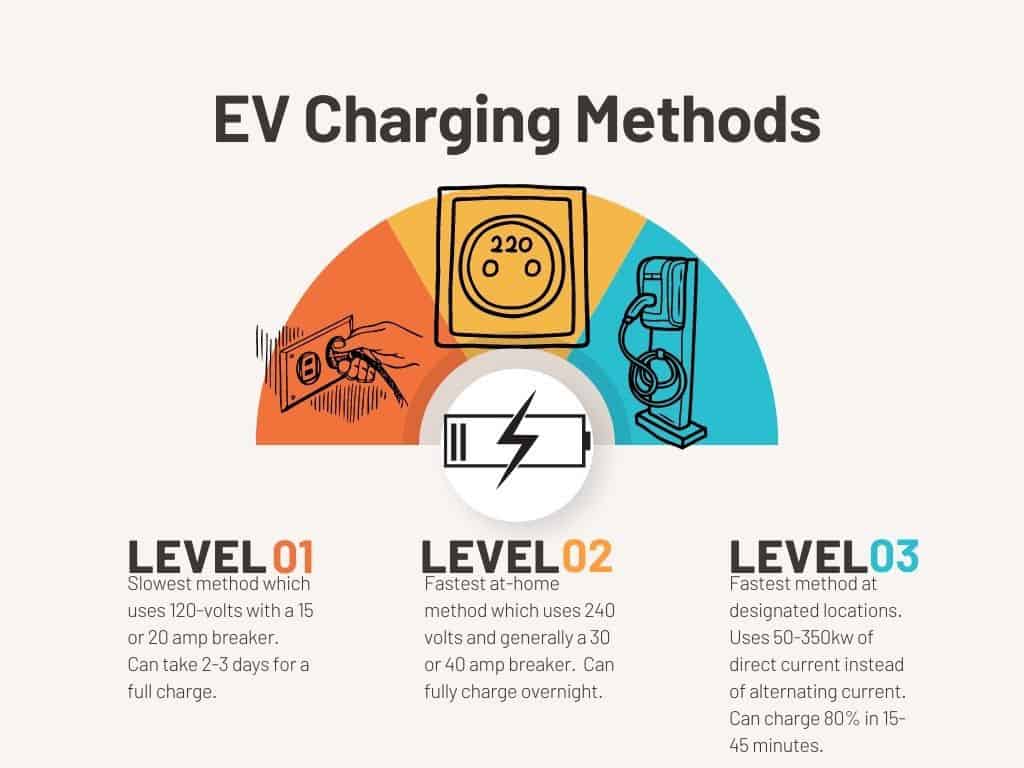
How Long to Charge an EV with Level 1 Charging
An average EV will gain about 4-7 miles per hour of level 1 charging and can take 2-3 days to fully charge from empty. Level 1 charging is the slowest EV charging method and is done at 120 volts of alternating current from a typical household receptacle with either 15 or 20 amps on a dedicated breaker.
Level 1 charging is the simplest since it will require no rewiring of anything in order to do. If you have a basic 120-volt receptacle in your garage (which nearly everyone has), then you can charge your electric vehicle by simply plugging into that outlet.
The amperage of 120-volt breakers will usually be 15 or 20, depending on what they are feeding. A bedroom will probably run on 15, while the microwave and kitchen outlets will be on a 20-amp breaker. Keep in mind that a circuit breaker’s rated current is only about 80% of its total. So a 15-amp breaker will not want to exceed 12 amps for an extended period of time or it will trip the breaker.
Check the capability of your EVSE to see if it can handle a 15 or 20-amp circuit, or if it’s limited to one of them.
Remember, Amps x Volts = Watts. Also, 1,000 watts = 1kW
Let’s do the math for a the following 120-volt breakers:
- 15-amp breaker: 120-volts x 12-amps = 1,440 watts, or 1.44kW
- 20-amp breaker: 120-volts x 16-amps = 1,920 watts, or 1.92kW
We must now consider the inefficiencies when charging.
Remember, your car is being supplied with AC current from the grid and it has to convert this electricity to DC current for your battery to accept. We lose efficiency during the conversion and while heat is generated (in the cords, in the converter, in the battery cells, etc.), ambient temperatures, internal resistance from your battery, the heat your EV uses to keep the battery at the optimal charging temp, among other factors.
To charge your battery 1kWh, you’ll probably need to use 1.2kW, since we can expect around a 15-20% inefficiency when charging.
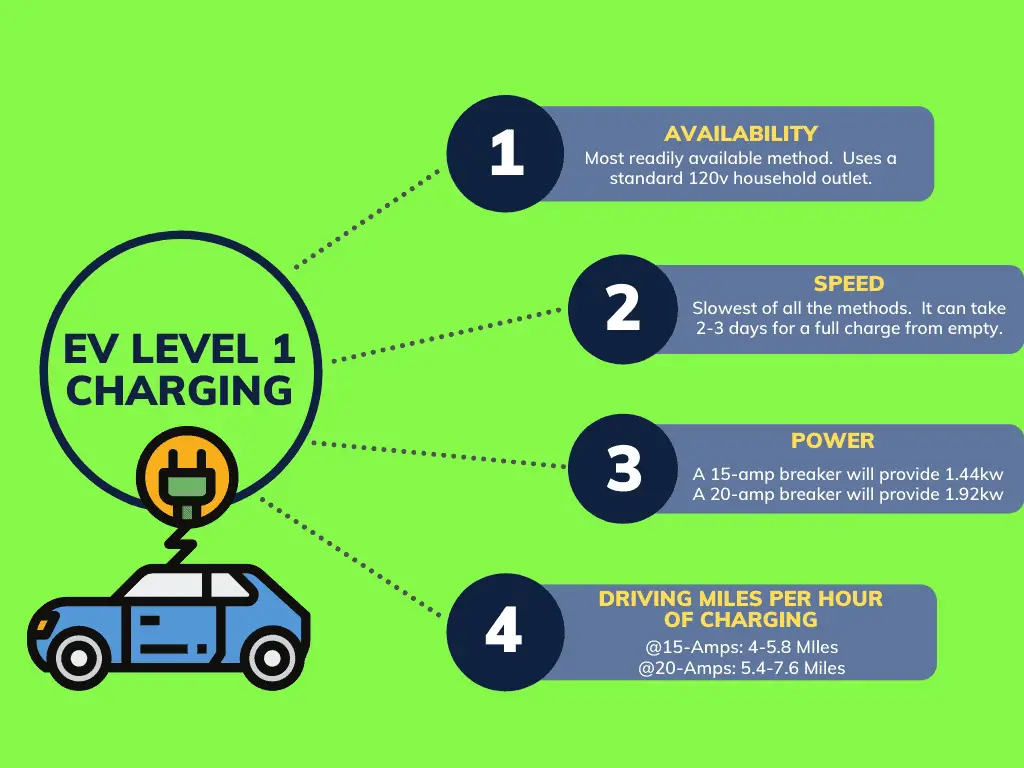
How to Calculate Level 1 EV Charging Times
To calculate how long it will take to charge an EV with level 1 charging, you need to first identify how many kWh (kilowatt hours) you need to replace in your EV battery.
Take the following steps to figure out how to determine the kWh to be charged:
- Step 1: Find the net battery capacity of your vehicle (or usable portion of the battery for propulsion) using this website
- Step 2: See what percentage your battery is at and subtract that number from 100
- Step 3: Multiply the number from Step 2 as a percentage (0.XX) by the total net battery capacity
- Step 4: Multiply the total kilowatts of your breaker (1.44 for a 15-amp breaker, or 1.92 for a 20-amp breaker) by the charging efficiency (I’m using 0.8, which is close to typical in decent conditions)
- Step 5: Divide the answer in Step 3 by the answer in Step 4
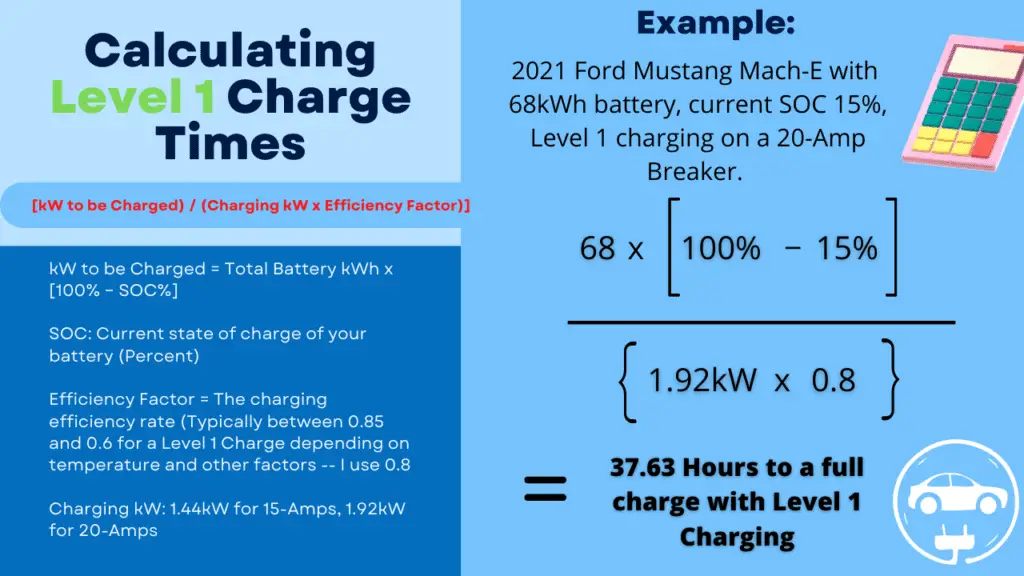
Example:
Let’s look at the Tesla Model Y on the top row of the table below. Let’s pretend that the battery is at 5% state of charge and the total Net Capacity is 75kWh. The breaker we’re using is a 20-amp breaker and we’ll roll with a 20% inefficiency (or 80% efficiency factor).
- 100 – 5 = 95% that needs to be recharged
- 0.95 x 75kWh = 71.25kWh to be recharged
- 71.25kWh / 1.92 x 0.8 = 46.4 Hours to charge
I did all of the calculations in the table below by calculating the charging time for replenishing 100% of the battery capacity and not a fraction of it.
This table shows the Level 1 charging times (in hours) with 15 and 20-amp breakers for the top 11 selling EV models in the last year.
| EV Model | Year | Net Battery Capacity (kWh) | Level 1 Charging Time (Hours) @15A from Empty | Level 1 Charging Time (Hours) @20A from Empty |
|---|---|---|---|---|
| Tesla Model Y | 2020 | 75 | 65 | 49 |
| Tesla Model 3 | 2020 | 57.5 | 50 | 37 |
| Ford Mustang Mach E | 2021 | 68 | 59 | 44 |
| Chevy Bolt EV | 2021 | 60 | 52 | 39 |
| Volkswagen ID.4 | 2021 | 77 | 67 | 50 |
| Nissan Leaf | 2021 | 37 | 32 | 24 |
| Audi e-tron | 2021 | 86 | 75 | 56 |
| Porsche Taycan | 2021 | 71 | 62 | 46 |
| Tesla Model S | 2020 | 95 | 82 | 62 |
| Hyundai Kona Electric | 2021 | 64 | 56 | 42 |
| Tesla Model X | 2020 | 95 | 82 | 62 |
How Many Miles of Driving Range per Hour with Level 1 Charging?
On average, an electric vehicle will gain 4-7 miles of driving range per hour of Level 1 charging. Level 1 charging provides 1.44-1.92kW of power per hour, and an average EV will get 3-5 miles of range per kilowatt hour.
| Level 1 Charging Breaker Size | Driving Miles Gained per Hour of Charging |
|---|---|
| 15 Amp | 3.5 – 5.8 |
| 20 Amp | 4.6 – 7.7 |
You can calculate a solid ballpark estimate of the total miles of range gained per hour for your particular model, or any model that you’re looking at.
- Step 1: Locate your EV’s EPA MPGe rating (miles per gallon equivalent) with this website and divide the MPGe by 33.7
- Step 2: Multiply your answer from Step 1 by either 1.44kW for a 15-amp breaker, or 1.92kW for a 20-amp breaker
- Step 3: Multiply your answer from Step 2 by the charging efficiency factor (Again, I use 0.8, but you could use as low as 0.6 for really cold weather, or 0.9 great conditions)
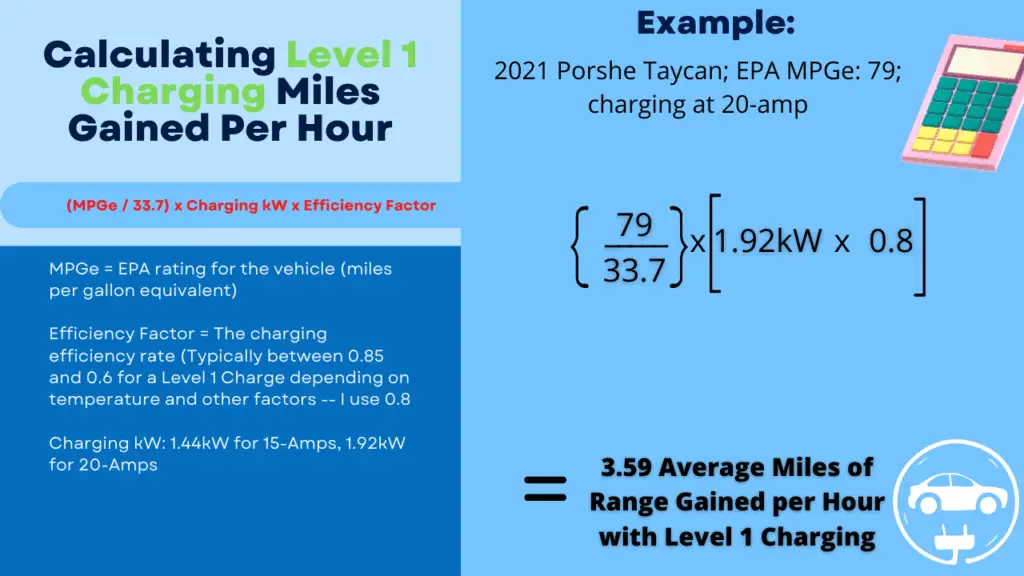
Example:
A 2020 Tesla Model Y has an EPA combined MPGe of 111 (you can use city, or highway if that’s what your primary driving consists of), we’ll be charging with a 20-amp breaker, and our efficiency factor will be 0.8.
- 111 / 33.7 = 3.29 miles per kilowatt hour
- 3.29 x 1.92kw = 6.32 miles of range before inefficiencies
- 6.32 x 0.8 = 5.1 miles of range per hour of Level 1 charging at 20-amps
Below you can check out the top selling 11 models over the last year and how many miles they gain per hour of Level 1 charging with 15 and 20 amps.
| EV Model | Year | Combined EPA MPGe | Miles Gained Per Hour with Level 1 Charging at 15A | Miles Gained Per Hour with Level 1 Charging at 20A |
|---|---|---|---|---|
| Tesla Model Y | 2020 | 111 | 3.79 | 5.05 |
| Tesla Model 3 | 2020 | 131 | 4.47 | 5.96 |
| Ford Mustang Mach E | 2021 | 93 | 3.18 | 4.24 |
| Chevy Bolt EV | 2021 | 118 | 4.03 | 5.38 |
| Volkswagen ID.4 | 2021 | 97 | 3.31 | 4.41 |
| Nissan Leaf | 2021 | 111 | 3.79 | 5.05 |
| Audi e-tron | 2021 | 78 | 2.66 | 3.55 |
| Porsche Taycan | 2021 | 79 | 2.7 | 3.59 |
| Tesla Model S | 2020 | 109 | 3.72 | 4.96 |
| Hyundai Kona Electric | 2021 | 120 | 4.1 | 5.47 |
| Tesla Model X | 2020 | 90 | 3.08 | 4.1 |
Charging an EV with Level 2 Charging
Many electric vehicles (EV) that you purchase today will include a Level 2 EVSE (electric vehicle supply equipment). It’s definitely a step up from the turtle speed of Level 1 charging, but just how much faster is Level 2 charging?
An average EV will gain about 15-40 miles per hour of level 2 charging and will fully charge from empty overnight. Level 2 charging is the fastest at-home EV charging method and is done at 240 volts of alternating current. Generally, a dedicated 30 or 40-amp breaker is used for Level 2 charging.
How Fast is Level 2 EV Charging?
Level 2 charging at 240-volts will charge at a speed of 3.85kW with a 20-amp breaker, 5.76kW with a 30-amp breaker, and 7.65kW with a 40-amp breaker. These speeds will fully charge an average electric vehicle overnight and generally replenish about 11-31 driving miles per hour of charging with the aforementioned breakers.
Level 2 charging uses a 240-volt outlet that you would typically use for an electric dryer or an electric range. 240-volts is twice the amount of pressure behind the amps as you’d find in a typical 120-volt household outlet.
If you trace the wires from your outlet back through the walls, they’ll all converge at your main breaker box. Inside that box you’ll generally see that the 240-volt breakers are either 15, 20, 30, or 40-amps in size.
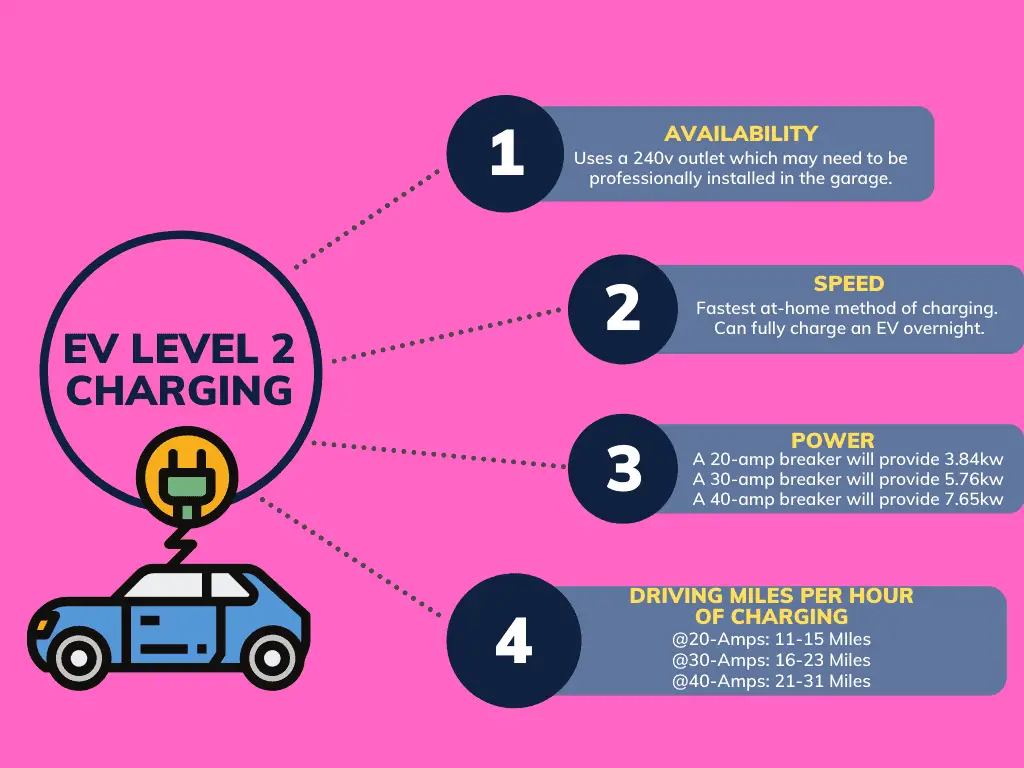
A 15 or 20-amp breaker might be used for a well pump, a 30-amp might be used for the AC and an electric dryer, and the 40-amp might be used for the electric stove and range.
It is highly recommended that you have a dedicated breaker for your EV when charging, which means that you won’t be powering anything else except your EV from that breaker.
Any breaker will have rated running amps of 80% of the number on the breaker itself. So, a 20-amp breaker will actually operate at 16 amps, and a 40-amp breaker at 32. It can go a little higher for short periods before tripping, but it doesn’t want to exceed 80%.
Below we can see how many kilowatts are streamed through each of the outlets based on their breaker size:
- 20-amp Breaker: 240-volts x 16-amps = 3.84kw
- 30-amp Breaker: 240-volts x 16-amps = 5.76kw
- 40-amp Breaker: 240-volts x 32-amps = 7.65kw
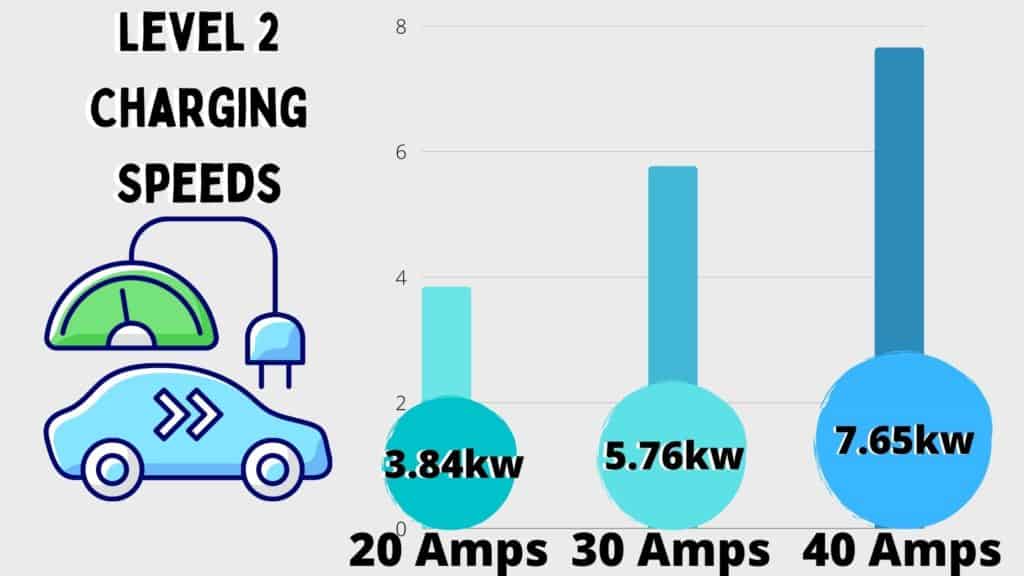
An important thing to keep in mind is that when using 120 or 240-volts of electricity, the charger is actually located inside the car — you’re just providing power to it via the EVSE. The internal charger of every make and model will have a limit to how much electricity it can accept.
Most makes and models can fully accept a Level 2 charge from a 40-amp breaker. You can have an electrician upgrade your main panel to supply higher amperages, but your EV might not be able to accept it if you did and the upgrade would be a waste of money.
For instance, as you’ll see in the table in the next section, a 2021 Nissan Leaf has a small battery capacity to begin with (37kWh) and maxes out at 6.6kW for Level 2 charging. It cannot even fully accept the charge from a 40-amp breaker. Upgrading your panel to a higher breaker would be pointless.
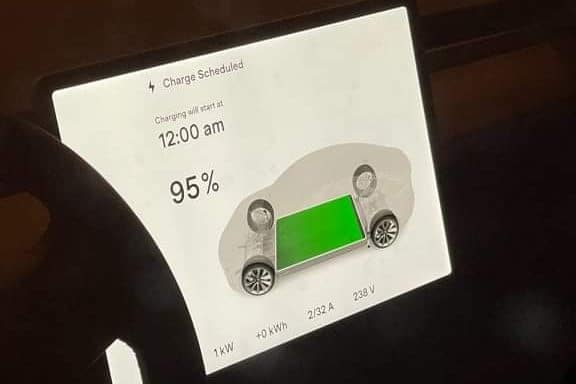
How Long Does it Take to Charge an EV with Level 2 Charging?
When determining how long it will take to charge an electric vehicle with Level 2 charging, you first need to figure out how many kWh (kilowatt hours) you need to replace in your EV’s battery.
Use the following steps to figure out how to determine the kWh to be charged:
- Step 1: Find the net battery capacity of your vehicle (or usable portion of the battery for propulsion) using this website
- Step 2: See what percentage your battery is at and subtract that number from 100
- Step 3: Multiply the number from Step 2 as a percentage (0.XX) by the total net battery capacity
- Step 4: Multiply the total kilowatts of your breaker (3.84 for a 20-amp breaker, or 5.76 for a 30-amp breaker, and 7.65 for a 40-amp breaker) by the charging efficiency factor (I generally use 0.8 to simulate average conditions, but you may want to drop as low as 0.6 if your car is in an unheated garage in the winter)
- Step 5: Divide the answer from Step 3 by the answer in Step 4
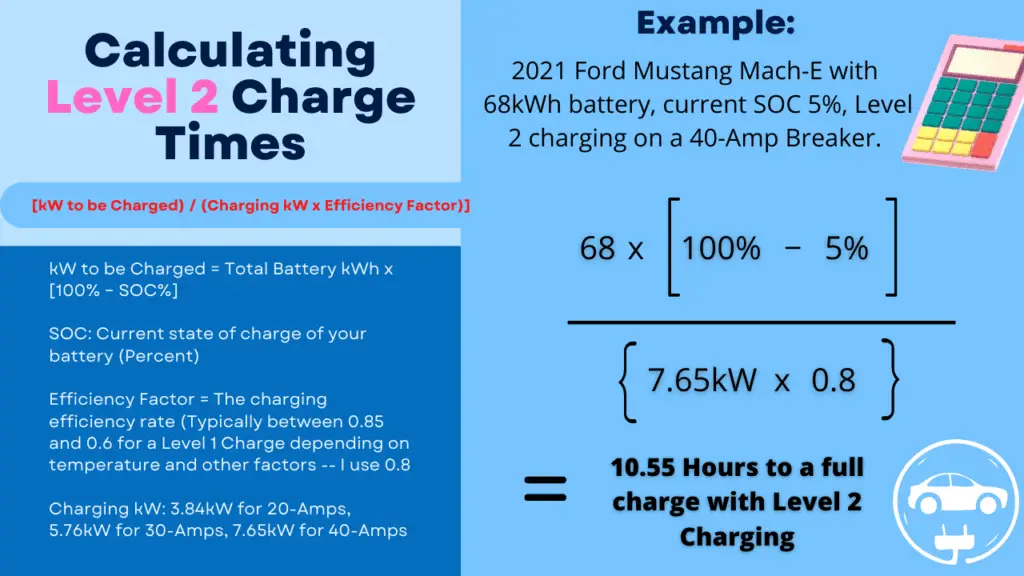
Example:
Let’s look at the Tesla Model Y on the top row of the table below. Let’s pretend that the battery is at 10% state of charge and the total Net Capacity is 75kWh. The breaker we’re using is a 40-amp breaker and we’ll roll with an 80% efficiency factor.
- 100% – 10% = 90% that needs to be recharged
- 0.90 x 75kWh = 67.5kWh to be recharged
- 67.5kWh / (7.65 x 0.8) = 11 Hours to charge
All of the calculations in the following table were done by calculating the charging time for replenishing 100% of the battery capacity and not a fraction of it.
This table shows the Level 2 charging times (in hours) with 20, 30, and 40-amp breakers for the top 11 selling EV models in the last year.
| EV Model | Year | Gross Battery Capacity (kWh) | Internal Level 2 Charging Limit in Kilowatts | Level 2 Charging Time (Hours) @20A from Empty | Level 2 Charging Time (Hours) @30A from Empty | Level 2 Charging Time (Hours) @40A from Empty |
|---|---|---|---|---|---|---|
| Tesla Model Y | 2020 | 75 | 11.5 | 24 | 16 | 12 |
| Tesla Model 3 | 2020 | 57.5 | 7.6 | 19 | 12 | 9 |
| Ford Mustang Mach E | 2021 | 68 | 10.5 | 22 | 15 | 11 |
| Chevy Bolt EV | 2021 | 60 | 7.2 | 20 | 13 | 10 |
| Volkswagen ID.4 | 2021 | 77 | 11 | 25 | 17 | 13 |
| Nisan Leaf | 2021 | 37 | 6.6 | 12 | 8 | 7 |
| Audi e-tron | 2021 | 86 | 9.6 | 28 | 19 | 14 |
| Porsche Taycan | 2021 | 71 | 9.6 | 23 | 15 | 12 |
| Tesla Model S | 2020 | 95 | 11.5 | 31 | 21 | 16 |
| Hyundai Kona Electric | 2021 | 64 | 7.2 | 21 | 14 | 10 |
| Tesla Model X | 2020 | 95 | 11.5 | 31 | 21 | 16 |
How Many Miles of Driving Range per Hour with Level 2 Charging?
On average, an electric vehicle will gain 11-31 miles of driving range per hour of Level 2 charging depending on whether a 20, 30, or 40-amp breaker is used. Larger breakers for faster charge times can be professionally installed. Level 2 charging provides 3.84-7.65kW of power per hour, and an average EV will get 3-5 miles of range per kilowatt hour.
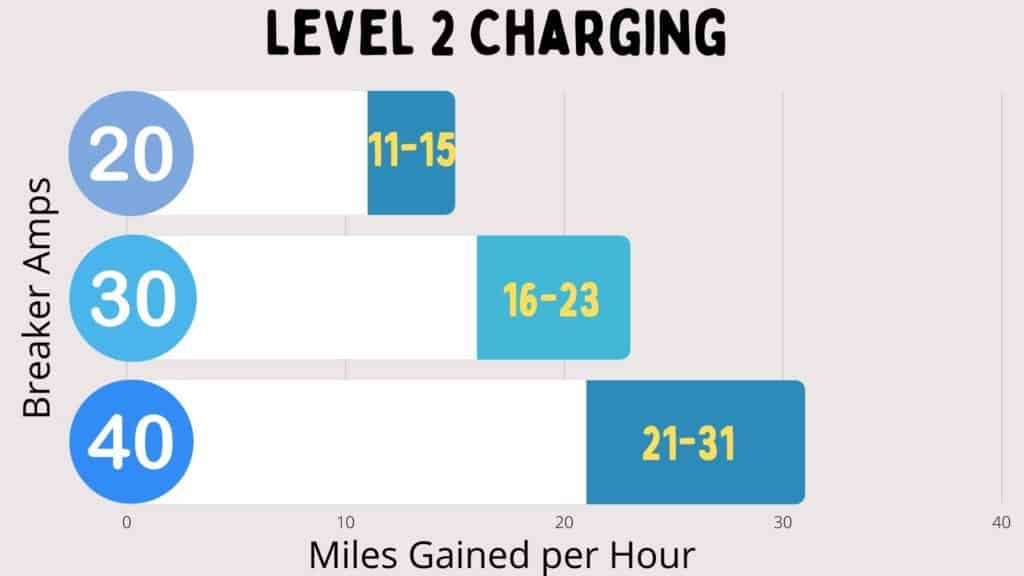
| Level 2 Charging Breaker Size | Miles Gained Per Hour of Charge |
|---|---|
| 20 Amp | 11 – 15 |
| 30 Amp | 16 – 23 |
| 40 Amp | 21 – 31 |
You can calculate a solid ballpark estimate of the total miles of range gained per hour for your particular model, or any model that you’re interested in by following these steps:
- Step 1: Locate your EV’s EPA MPGe rating (miles per gallon equivalent) with this website and divide the MPGe by 33.7
- Step 2: Multiply your answer from Step 1 by either 3.84kW for a 20-amp breaker, or 5.76kW for a 30-amp breaker, or 7.65 for a 40-amp breaker
- Step 3: Multiply your answer from Step 2 by the charging efficiency factor (Again, I use 0.8, but you could use as low as 0.6 for really cold weather, or 0.9 great conditions)

Example:
A 2020 Tesla Model Y has an EPA combined MPGe of 111 (you can use city, or highway if that’s what your primary driving consists of), we’ll be charging with a 40-amp breaker, and our efficiency factor will be 0.8.
- 111 / 33.7 = 3.29 miles per kilowatt hour
- 3.29 x 7.65kW = 25.17 miles of range before inefficiencies
- 25.17 x 0.8 = 20.14 miles of range per hour of Level 1 charging at 20-amps
Below you can check out the top selling 11 models over the last year and how many miles they gain per hour of Level 1 charging with 20, 30, and 40 amps.
| EV Model | Year | Combined EPA MPGe | Miles Gained Per Hour with Level 2 Charging at 20A | Miles Gained Per Hour with Level 2 Charging at 30A | Miles Gained Per Hour with Level 2 Charging at 40A |
|---|---|---|---|---|---|
| Tesla Model Y | 2020 | 111 | 10.1 | 15.16 | 20.13 |
| Tesla Model 3 | 2020 | 131 | 11.92 | 17.88 | 23.74 |
| Ford Mustang Mach E | 2021 | 93 | 8.48 | 12.72 | 16.89 |
| Chevy Bolt EV | 2021 | 118 | 10.75 | 16.13 | 21.42 |
| Volkswagen ID.4 | 2021 | 97 | 8.82 | 13.22 | 17.56 |
| Nissan Leaf | 2021 | 111 | 10.1 | 15.16 | 20.13 |
| Audi e-tron | 2021 | 78 | 7.1 | 10.64 | 14.14 |
| Porsche Taycan | 2021 | 79 | 7.19 | 10.74 | 14.32 |
| Tesla Model S | 2020 | 109 | 9.92 | 14.88 | 19.77 |
| Hyundai Kona Electric | 2021 | 120 | 10.94 | 16.4 | 21.79 |
| Tesla Model X | 2020 | 90 | 8.2 | 12.3 | 16.34 |
Charging an EV with Level 3 Charging
Not all, but the majority of electric vehicles on the market today are capable of Level 3 Charging. Some call this “rapid charging”, “DC Fast Charging”, “fast charging”, etc.
This isn’t a charging process you do at your home, but rather at a charging station that you pay to use and are frequently located along major highways.
Whenever anyone researches EVs, one of the most common questions is what is the absolute fastest method to charge their car.
Level 3 charging is the fastest method of charging an electric vehicle and can recharge a battery up to 80% in 15-45 minutes. Level 3 charging takes place in commercial locations and supplies 50-350kw of direct current (DC) power directly to the battery and bypasses the EV’s limited onboard charger.
Level 3 charging is not done at home, but rather at specially built locations. You can locate your nearest station with the plugshare website.
How Fast is Level 3 EV Charging
Level 3 charging is the fastest method of charging and supplies 3-20 times more power than higher rates of Level 2 charging. The slowest Level 3 charging station will still be at least 3x faster than the fastest Level 2 charging rates.
Level 1 charging can take 2-3 days for a full recharge. Level 2 charging can take 10-15 hours. Level 3 charging only takes 15-45 minutes for an 80% charge.
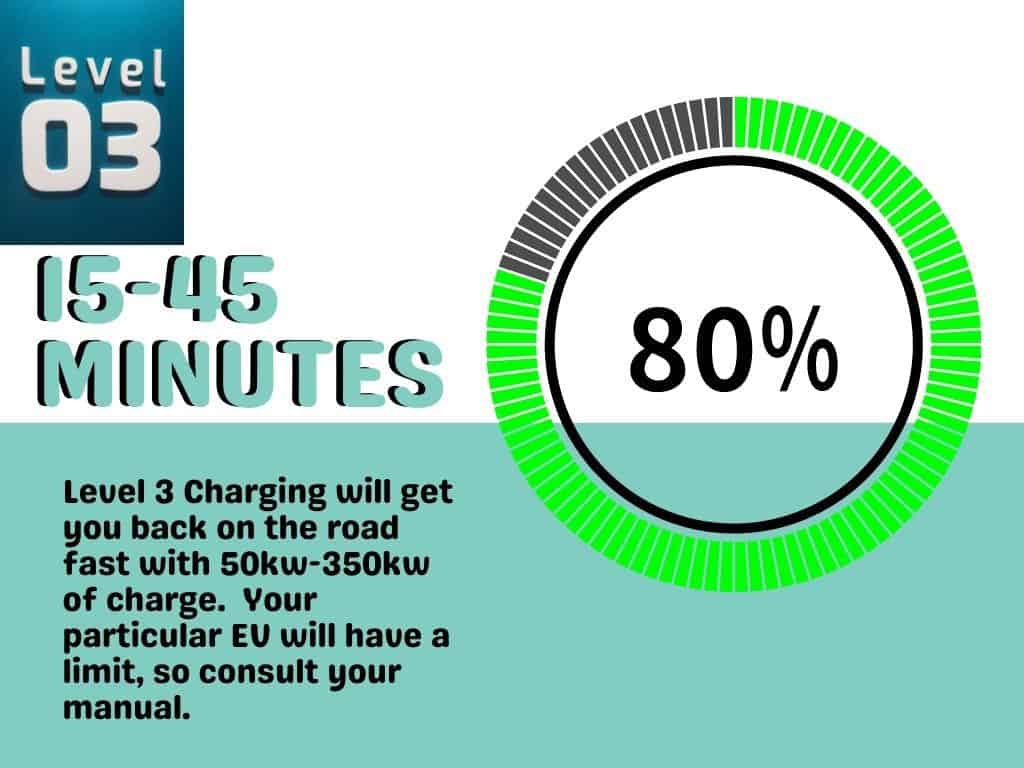
The reason Level 3 charging is only calculated up to 80% is because as the internal resistance of the battery builds up, the supply power must be dramatically reduced in order to prevent overheating and damage to the battery.
The high charging rates of Level 3 charging are readily accepted by the battery until the 80% mark. After that, the EV’s onboard computers will stop the process to severely throttle it.
Below is a table where I calculated the Level 3 charging times for the 11 top selling EVs in the last year.
There’s a couple things to keep in mind:
- Just because the EV takes longer to charge doesn’t mean that it is “worse” than the others, as some electric vehicles have much larger batteries and therefore more range
- All electric vehicles have a maximum kilowatt rate that they can accept when charging at Level 3 (as well as Level 2), so just because you bring your Nissan Leaf to a 350kw charger doesn’t mean it can accept that much
- The times below are in minutes, and not hours
| EV Model | Year | Net Battery Capacity (Usable) | Model’s Level 3 Charging Limit in Kilowatts | Level 3 Minutes from 0% to 80% charge at 50kw | Level 3 Minutes to 80% charge at 100kw | Level 3 Minutes to 80% charge at 250kw |
|---|---|---|---|---|---|---|
| Tesla Model Y | 2020 | 75 | 210 | 76 | 37 | *15 |
| Tesla Model 3 | 2020 | 57.5 | 250 | 58 | 19 | 12 |
| Ford Mustang Mach E | 2021 | 68 | 115 | 69 | 34 | *30 |
| Chevy Bolt EV | 2021 | 60 | 55 | 61 | *55 | *55 |
| Volkswagen ID.4 | 2021 | 77 | 125 | 78 | 39 | *31 |
| Nissan Leaf | 2021 | 37 | 46 | *40 | *40 | *40 |
| Audi e-tron | 2021 | 86 | 110 | 87 | 43 | *40 |
| Porsche Taycan | 2021 | 71 | 225 | 72 | 36 | *16 |
| Tesla Model S | 2020 | 95 | 200 | 96 | 48 | *24 |
| Hyundai Kona Electric | 2021 | 64 | 75 | 65 | *43 | *43 |
| Tesla Model X | 2020 | 95 | 200 | 96 | 48 | *24 |
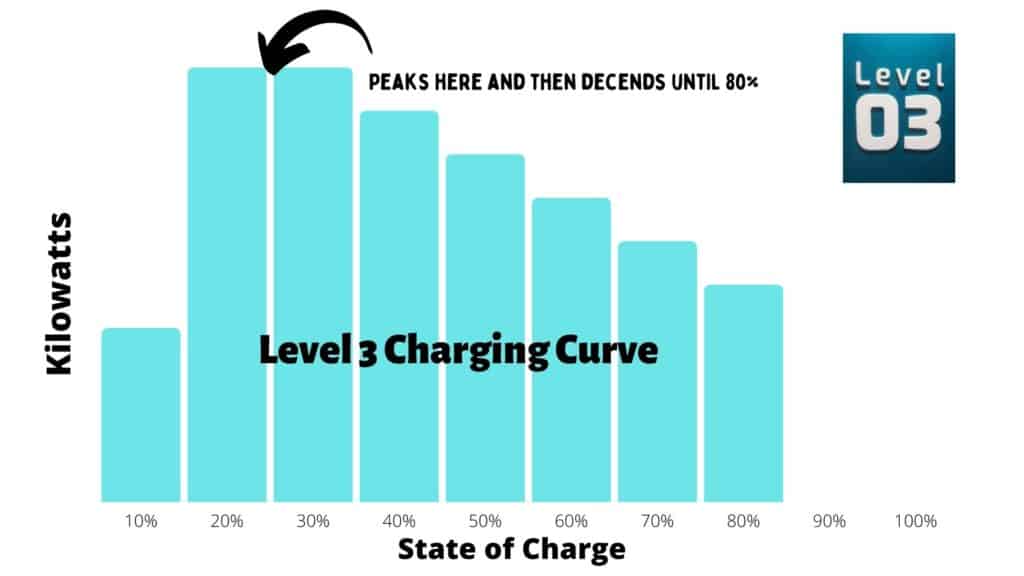
How Much Power Does Level 3 Charging Supply
The current range for Level 3 charging is from 50kW to 350kW, though most electric cars are presently not capable of charging at the 350kW rate and fall at 250kw or below.
Level 3 charging works with Direct Current (DC) and not Alternating Current (AC).
When you charge your vehicles at home with Level 1 or Level 2 charging, you are using AC power from your wall outlets. That electricity enters into the EV via the EVSE and the onboard charger converts that AC into DC electricity. That conversion process lowers charging efficiency.
DC fast charging, or Level 3, converts the AC power to DC at the station itself and the station itself is the charger. When you hook up the EVSE, the electricity flows directly into the battery and bypasses the onboard charger.
Keep in mind that if you are occupying a charging station that supplies more kilowatts of power than your vehicle can accept and you pay by the minute, you will be charged for the full potential of the station’s charger rather than the reduced total that your vehicle can accept.
How to Easily Calculate Level 3 Charge Times
Calculating Level 3 charging times to get ballpark estimates is quite simple to do.
When determining how long it will take to charge an electric vehicle with Level 3 charging, you first need to figure out how many kWh (kilowatt hours) you need to replace in your EV’s battery.
Use the following steps to figure out how to determine how long it will take to charge your EV:
- Step 1: Find the net battery capacity of your vehicle (or usable portion of the battery for propulsion) using this website
- Step 2: Identify what state of charge (percentage) your battery is currently at
- Step 3: Add that number to 20 and subtract the total from 100 to get the percentage that needs to be charged (we only need to charge to 80%, so that’s where the number 20 came from because 20% of the battery won’t be affected)
- Step 4: Take the percentage calculated in Step 3 and multiply it by the net capacity of the EV battery
- Step 5: Take total kilowatts of the charging station (or the max that your car can accept if you’re at a station with higher kilowatts than your car can take) and multiply it by the efficiency factor (I generally use 0.95 for Level 3 charging)
- Step 6: Divide Step 4’s answer by Step 5’s answer.
- Step 7: Multiply the answer from Step 6 by 60 minutes to get the total time in minutes
Example:
Let’s say we want to charge a 2021 Ford Mustang Mach-E which has a 68kWh battery at a 150kW Level 3 charging station. The current state of charge of the battery is 15%.
- 15% + 20% = 35%
- 100% – 35% = 65%
- 68kWh x 0.65 = 44.2kWh that need to be recharged to reach 80% capacity
- 44.2kWh / 115kW = 0.38435 hours (115kW is the Level 3 charging limit of the Mach-E, so it cannot reach the full 150kW of the station)
- 0.38435 / 0.95 efficiency factor = 0.405 hours
- 0.405 x 60 minutes = 24 minutes
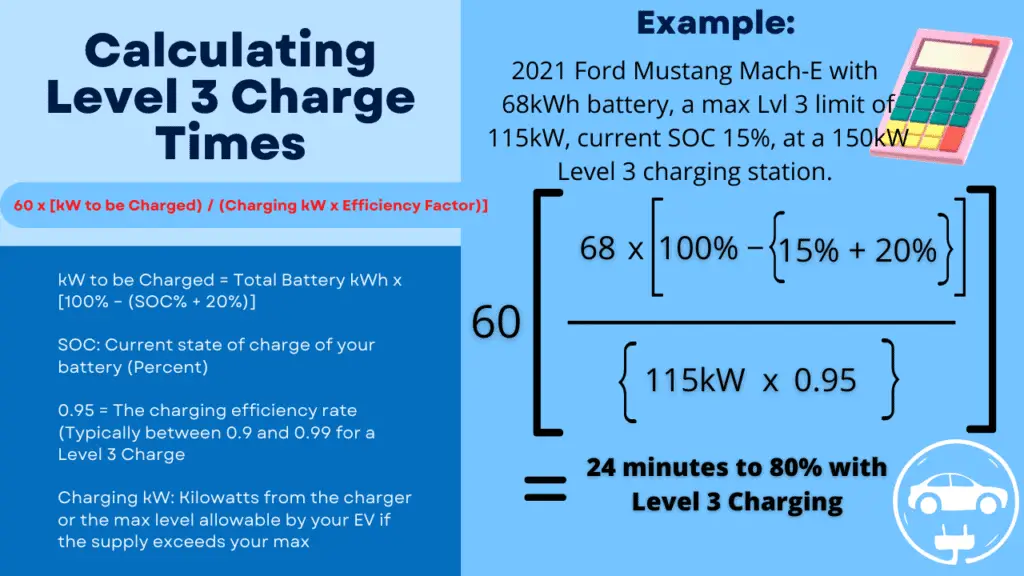
How Many Miles of Range are Gained per Minute of Level 3 Charging
A typical EV will easily gain 8-20+ miles of range per minute of Level 3 charging on average depending on the kilowatts supplied. The first third of the charging session will yield the highest results as the rate of absorption is highest by the battery at the start when its internal resistance is lower.
To calculate the miles of range that your EV will gain per minute of charging, just follow these steps:
- Step 1: Locate your EV’s MPGe from this website.
- Step 2: Divide the MPGe by 33.7
- Step 3: Multiply the answer in Step 2 by the kilowatts of the Level 3 charger (or what your car maxes out at if the charger is oversized)
- Step 4: Multiply the answer in Step 3 by an efficiency factor to get the theoretical miles gained per hour of charging (I use 0.95 for Level 3 charging)
- Step 5: Divide the answer in Step 4 by 60 minutes to get the average miles gained per minute of Level 3 charging
Example:
Let’s take the 2021 Porsche Taycan which has a combined EPA MPGe of 79 and pretend that we pull up to a 250kW Level 3 charger. The Taycan limits itself to 225kW for Level 3 charging.
- 79 MPGe / 33.7 = 2.344 Miles per kilowatt hour of battery charge
- 2.344 x 225kW x 0.95 Efficiency = 501.1
- 501.1 / 60 minutes = 8.35 average miles of driving range gained per minute of Level 3 charging
If we compare that to the standard range 2020 Tesla Model 3, which has a combined EPA MPGe of 131, a limit of 250kW, and we pull up the same charger, our results would look like the following:
- 131 / 33.7 = 3.89 Miles per kilowatt hour of battery charge
- 3.89 x 250kW x 0.95 Efficiency = 923.88
- 923.88 / 60 minutes = 15.4 average combined miles of driving range gained per minute of Level 3 Charging
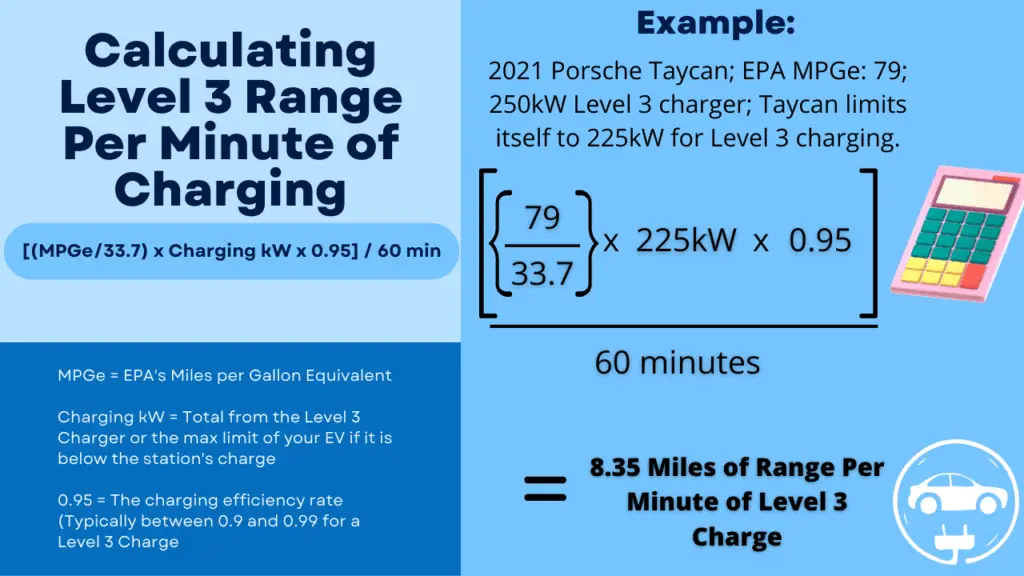
Factors That Effect Electric Vehicle Charging Times
This is a topic that warrants its own book. Since you made it this far and probably need a coffee refill, I’ll just touch on a few of the major ones and try to keep it brief.
- Temperature: Batteries are like people and perform best in room temperature environments. Cold temperatures will increase the charge time greatly, and you may see a 60% efficiency instead of an 80-90% efficiency that you’d see on a warmer day. In cold weather, a portion of the charge is actually used just to warm up your battery in order for it to be able to accept the charge. On the flip side, an excessively hot day will allow your battery to charge quickly, but the rapid rate and the lack of cooling will help diminish your battery’s lifespan.
- Internal Resistance: From 0 to 80%, your battery’s charge will be much faster than from 80-90%, and even faster than from 90-100%. This is due to the battery building up an internal resistance to the charge. As the battery is approaching full capacity, it cannot convert electrical energy into chemical energy fast enough and the onboard charger will reduce the current to avoid overheating.
- Supply: It goes without saying that if you have a low amperage, you’ll have a slower charge. You can only charge as fast as your supply will permit.
- Internal Limits of Charger: Your EV’s onboard charger will dictate the maximum rate that you can charge. Trying to charge a Chevy Bolt with an 80-amp breaker at 220 volts will be pointless since the Chevy Bolt maxes out at a 40-amp breaker.
- Age of the Battery: An older battery with more charging cycles under its belt will lost capacity over time due to irreversible chemical changes inside the cells of the battery. This will make it harder and slower for the battery to convert electrical energy into stored chemical energy.
- Fluctuations in Charging: Battery charging, when plotted on a graph is not a straight line from 0% to 100%. It will be more stable with Level 1 and Level 2 charging, but still taper off after 80% or 90% as the battery’s internal resistance builds. Charging with Level 3 can start relatively slow compared to the capacity of the charger, but it will peak between about 10% and 30% or so. After that, it tapers off until 80% state of charge. Not every minute or every hour of the charging process will yield the same charge to the battery. Typically, the charge from 0-80% will go much faster than from 80-100%.
